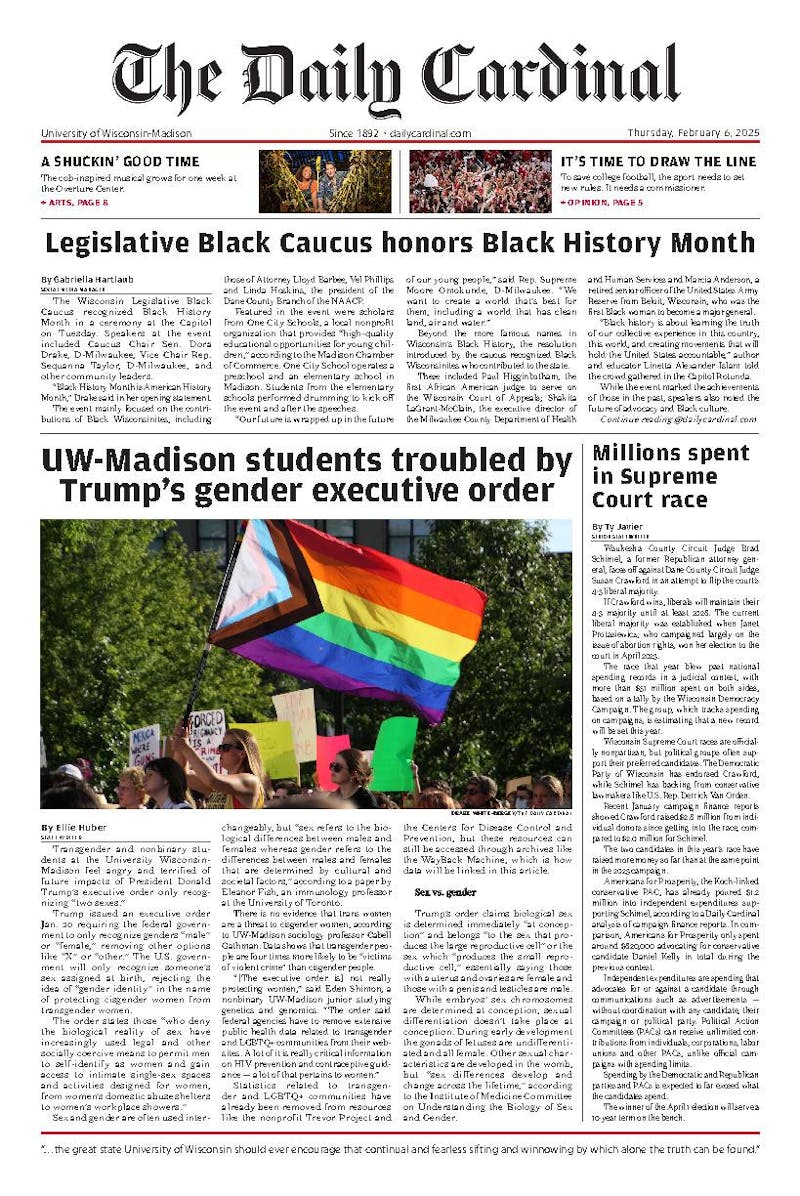Content warning: This story contains reference to domestic violence and drug abuse.
Broadway lurches toward an unfortunate trend of unoriginality, producing mainly shows based on already existing material like movies, books and, in the case of “Tina: The Tina Turner Musical,” iconic musicians. One is left to wonder: do shows like these merit existence, or are they merely cash grabs designed to lure us in through nostalgia?
This was the question on my mind as the curtain rose on “Tina: The Tina Turner Musical,” at the Overture Center for the Arts.
“Tina” is a jukebox musical that features the iconic discography of the artist while telling the story of her tumultuous rise to fame.
A jukebox musical is a show that consists primarily of already existing pop music, such as Mamma Mia! or Moulin Rouge! In addition to their use of an exclamation point in the title, these shows share the quality of being the most well-known examples of the genre.
Transparently, I knew very little about the life of our show’s subject prior to the performance. This lack of knowledge kept me engaged, especially as the show shifted through the distinct decades of Tina’s life.
The 1960s were represented with “Shake a Tailfeather,'' a highpoint of the show as Tina, her sister Alline and their Mod girlfriends got ready for a night out in St. Louis, finding the perfect outfits, styling their hair and of course, partaking in elaborate group choreography.
Tina’s Vegas residency was brought to life through “Disco Inferno,” a number that felt like the 1970s to a T, with backup singers wearing flared white jumpsuits and a remarkably powerful disco ball that bathed the theater in its light. “What’s Love Got to Do With It” rounded the decades out, in a performance just as big and beautiful as Tina’s classic 1980s hairdo.
Due to the nature of Tina’s early life, the show does contain serious subject matter such as familial abandonment, domestic violence and drug abuse. These topics are essential to a retelling of Tina’s life, and their inclusion was intended to demonstrate her strength and resilience.
But I am not sure the audience's reaction reflected this fact. The crowd erupted with cheers when Tina had to take physical action against her abusive husband and music partner, a reaction that felt tonally inappropriate.
It was clear to me the writers had somehow missed the mark in portraying how this situation truly affected Tina. I believe this was partially due to the minimal insight into the singer’s inner dialogue throughout the show. We heard about how this abuse affected her mother, and even her tour manager, but we never really heard about it from Tina herself.
Amid the more harrowing details of her life, a shining light persisted throughout the show’s narrative: dedication to celebrating the tradition of Black musicians.
Far too often, Black musicians are overlooked in the industry’s history. It was both refreshing and beautiful to see “Tina” fully embrace this aspect of the singer's identity through the costumes, casting and dialogue. Each piece made it apparent the creative team behind Tina set out to center the show around Blackness in a way that was surely powerful and important to audience members.
So, who do you enlist to capture the essence of such a distinct beloved figure in music history? The answer, I found during Tuesday’s performance, was Zurin Villanueva.
Villanueva blew the audience away with powerhouse vocals that made my throat sore just listening to them and kicks so high that, at times, it felt like they could reach me in the theater’s upper circle. She accomplished all this while showcasing a rather convincing Tina, which particularly shined in her performances of “River Deep – Mountain High” and “Proud Mary.”
Other cast highlights included Symphony King, who played young Anna Mae. King shocked the audience when she opened her tiny mouth and effortlessly filled the Overture Center with her expertly executed riffs.
Although the cast’s renditions were beautiful, I couldn’t help but wish they had material to perform outside the constraints of the jukebox genre. With artist-based musicals like “Tina,” performers are shoehorned into doing note-for-note impressions of material we’ve already seen on that stage, and can readily access thanks to the internet.

Zurin Villanueva performing 'Higher' Photo by Evan Zimmerman for MurphyMade.
The show’s set design also left something to be desired, using an underwhelming screen-based approach that even Villanueva's vocals couldn’t quite distract from.
At its best, the screen helped sell the ambiance of a 1980s Tina Turner arena tour, but, at its worst, which was unfortunately for a majority of the show, it made me feel like I was trapped inside of a lava lamp.
Despite this qualm with the production, I cannot deny that the last scene of “Tina” is breathtaking, filled with strobe lights, simulated sparks and a scenic layout that rightfully showcased the band. If only they could have pulled out these bells and whistles earlier in the runtime.
At the end of the day, “Tina” was an extraordinary showcase of vocal talent to the catchy soundtrack of rock n’ roll’s queen. It did not break the mold of your standard unoriginal jukebox musical, with its creativity and design leaving something to be desired. But it did provide a night of sonically pleasing fun at the theater.






